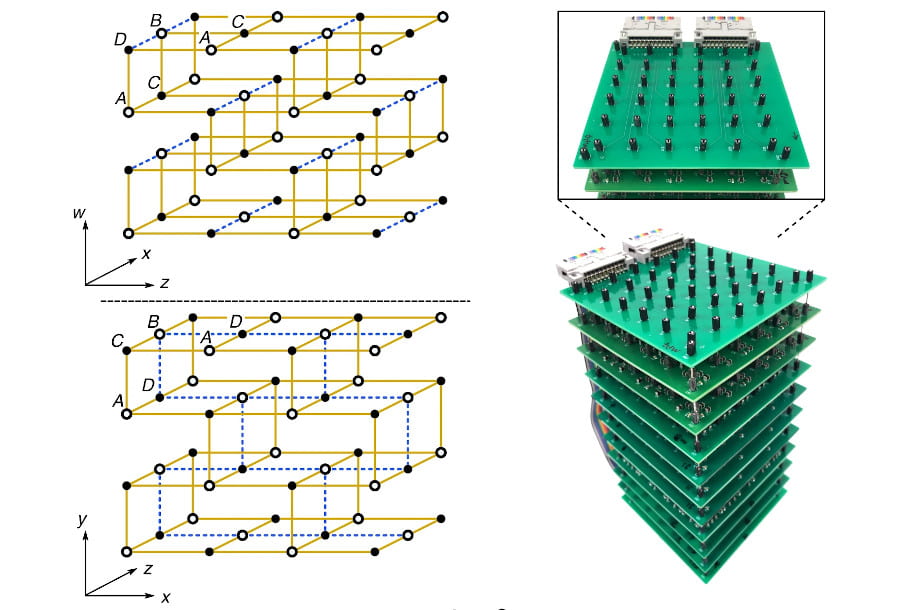
Experimental data showing waves flowing within a four-dimensional metamaterial. The left panel shows a 4D topological insulator, in which currents can only flow on the surface, while the right panel shows a 4D conventional insulator. Figure credit: Wang et al.
As we all know, space is three dimensional. Many aspects of physics, including the fundamental properties of matter, depend strongly on the dimensionality of space. For instance, 2D materials like graphene, in which the atoms are confined to a two dimensional plane, have properties very different from standard 3D materials. Now, researchers have created a synthetic material that behaves as though it has four dimensions (4D), higher than the number of dimensions in the space around us.
The team of physicists, from Nanyang Technological University (NTU Singapore) and the University of Birmingham in the UK, have achieved the first realization of a “Class AI topological insulator” – a material that is impossible to synthesize under ordinary conditions, as it requires four or more spatial dimensions. To accomplish this, they used electrical circuits with special interconnections that act as extra spatial dimensions. The experiment was reported in the journal Nature Communications in May 2020.
Topological insulators are a class of materials that differ from standard matter due to the distinctive way in which they conduct electricity. Like ordinary electrical insulators, they do not allow electric currents to flow inside them, yet electricity can flow unusually well along their surfaces. This efficient surface flow is the subject of intense research, because physicists believe they can be exploited for quantum computers, efficient information processors, and other devices.
There is not just a single type of topological insulator, however. Theoretical physicists have developed an elaborate classification for topological insulators, with different classes possessing strikingly different properties. The classification scheme is based on high-level mathematical concepts and accounts for all topological insulators discovered to date. But it also predicts hypothetical topological insulators that are seemingly impossible to realize, because they exist in 4D or even higher spatial dimensions.
Yidong Chong and Baile Zhang, two physics professors at NTU’s School of Physical and Mathematical Sciences, set out to create a 4D topological insulator by using an artificial material, or “metamaterial”.
To devise the 4D topological insulator, the team used a theoretical model invented by Hannah M. Price, a Birmingham Fellow and Royal Society University Research Fellow at the University of Birmingham, and a co-author of the paper. Price proved that the model is distinctively 4D by calculating a theoretical property called a “nontrivial second Chern number”, which is mathematically impossible for materials with three or fewer spatial dimensions.
The behavior of real materials comes from the properties of atoms, which stem from quantum mechanics. But the same properties can arise in metamaterials made from collections of non-quantum oscillators, which behave like artificial atoms. To create the 4D metamaterial, You Wang, a PhD student at NTU who is the lead author of the paper (who has since graduated and is now a research fellow at NTU), designed and fabricated a custom-made stack of printed circuit boards, similar to those found in consumer electronic devices. The circuit contains numerous electrical oscillators, as well as electrical connections between them.
The dimension of the circuit is effectively determined by the layout of the electrical connections within it. By placing “long-distance” interconnections between oscillators in different parts of the circuit, the team achieved a layout corresponding to higher dimensions than real space.

Schematic of the 4D metamaterial (left), and photographs of the experimental sample (right). Figure credit: Wang et al.
By careful measurements of the electrical properties of the stack, Wang showed that currents do not flow within the interior of the 4D structure, but can flow efficiently along its 3D surface. Moreover, when the metamaterial is tweaked to transform it from a 4D topological insulator into a 4D conventional insulator, the surface flow disappears, in agreement with theoretical predictions.
The “Class AI” topological insulator implemented in this experiment is only one of the many higher dimensional topological insulators predicted by theoretical physicists. Those higher dimensional materials can be implemented using a similar approach.
This work shows that even though some theoretical ideas seem to be forever beyond the reach of experiment, they can be turned into reality by using creative approaches. Looking ahead, the researchers aim to use circuit metamaterials to explore other exotic high-dimensional phenomena that were originally believed to be entirely hypothetical.
